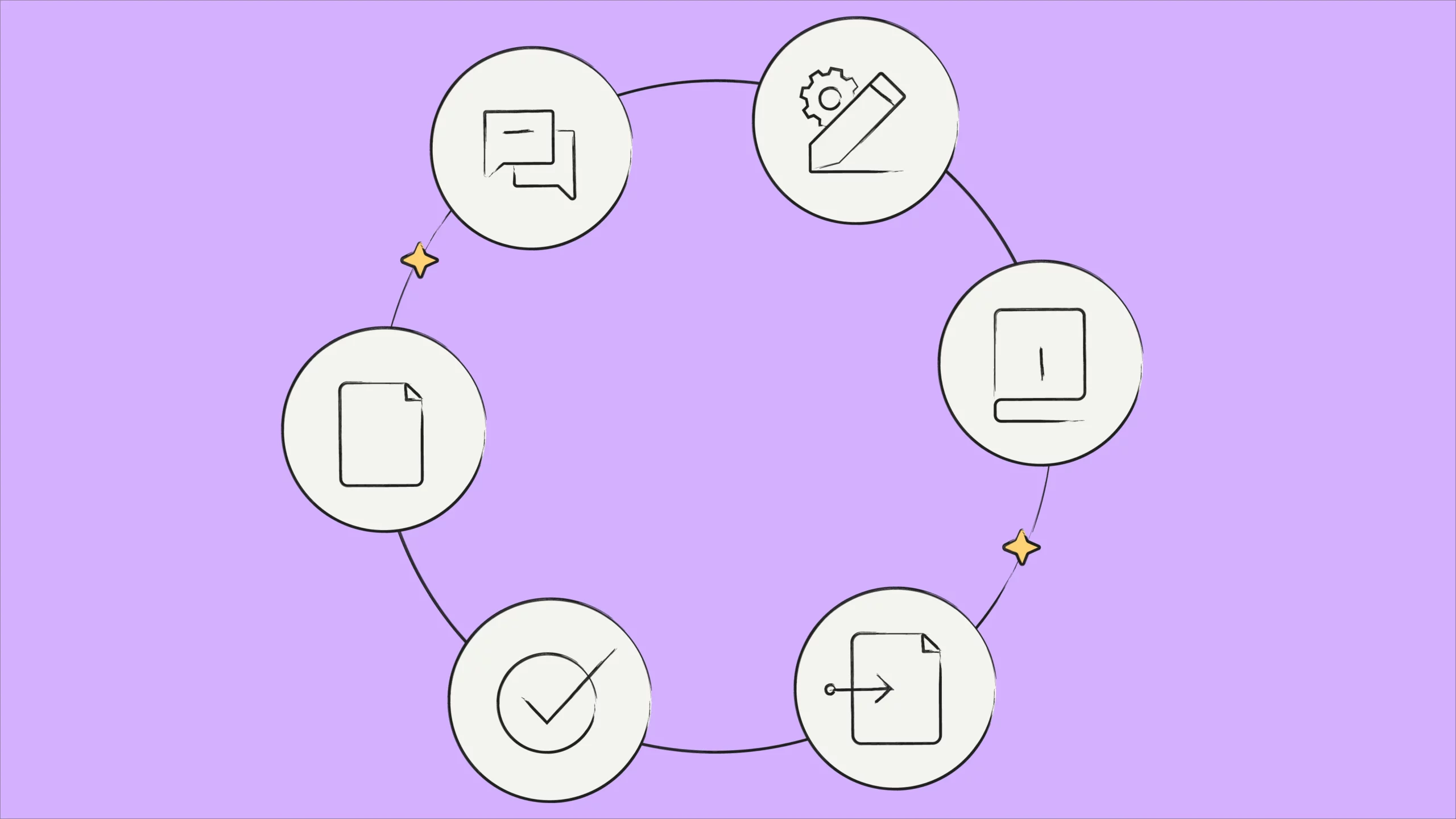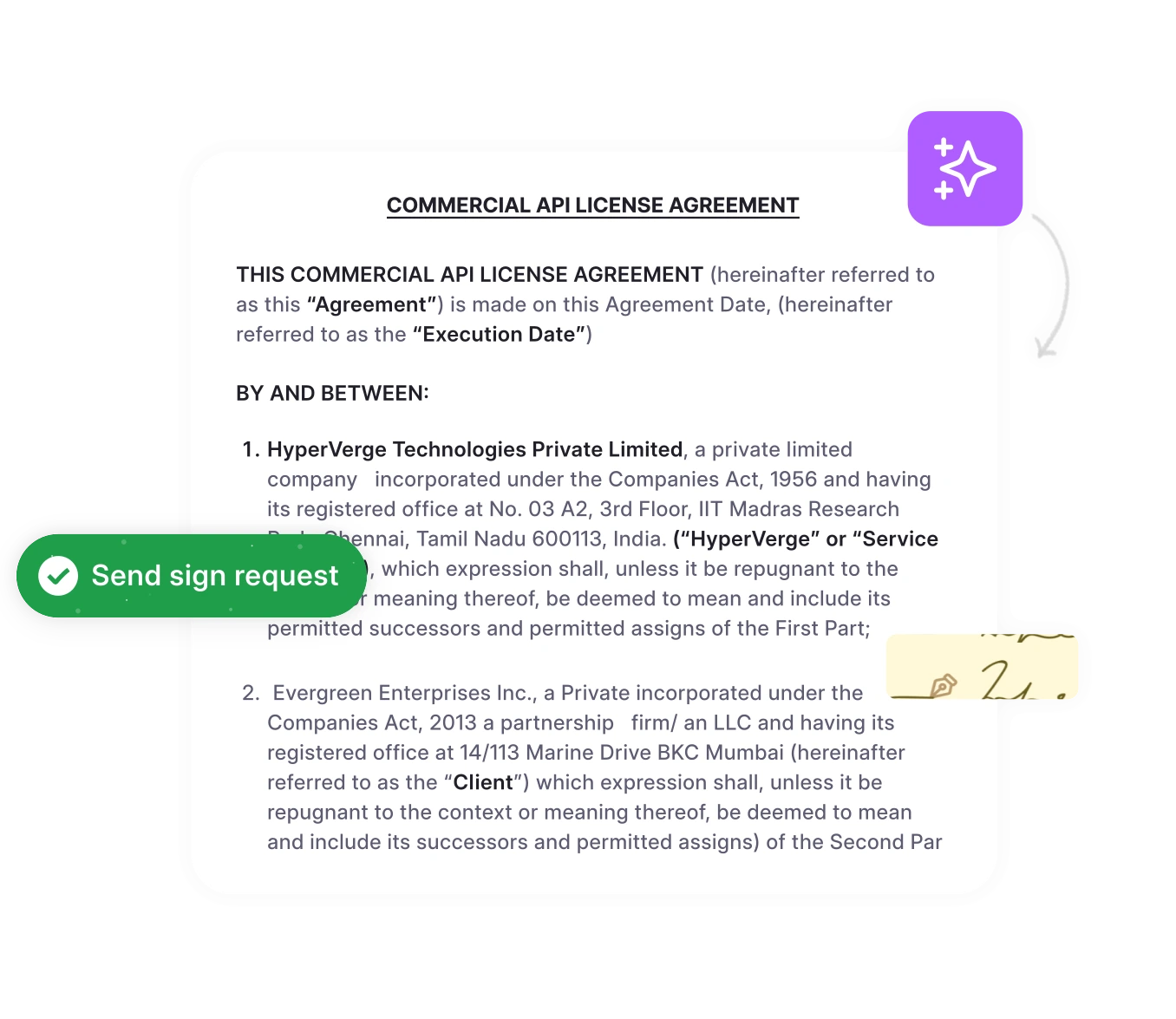In this guide, we’ll walk through everything you need to know about contract administration: what it means, why it matters, and how to build a process that actually works.
Picture this: Your finance team just discovered you’ve been overpaying a vendor by 15% for the past six months. Why? Because nobody noticed when their pricing changed—despite having a contract that clearly outlined the rates.
Or imagine your legal team scrambling during an audit, spending hours hunting down a three-year-old supplier agreement that’s supposedly “somewhere in the shared drive.”
Companies lose roughly 10% of their annual revenue because of poor contract management practices. That’s not chump change. For most businesses, that’s millions of dollars disappearing into missed deadlines, unenforced terms, and obligations that fell through the cracks.
Understanding contract administration
Contract administration is everything that happens after the signatures dry. It’s making sure everyone does what they promised to do, when they promised to do it, and how they promised to do it.
Now, contract administration cannot be confused with contract management. Contract management is the big picture—strategy, negotiation, portfolio optimization. Contract administration is the ground-level execution—tracking deliverables, monitoring compliance, managing amendments, making sure what you agreed to actually happens.
For legal teams, this means maintaining the integrity of contractual terms. For finance teams, it means ensuring payment schedules align with deliverables and catching budget issues before they blow up your forecast.
The main goal of contract administration
At its core, contract administration exists to ensure contracts are executed, monitored, and renewed efficiently while supporting compliance, performance accountability, and positive business outcomes.
But there’s a deeper principle here—one that applies whether you’re managing enterprise agreements or small business contracts.
Joy Azubuike, a contract administrator, puts it simply:
“The same contract administration principles that keep large projects running smoothly can also help small businesses stay organized, grow, and succeed. Here are three simple lessons:
- Deadlines keep you reliable.
- Documentation keeps you safe.
- Relationships keep you growing.
Which of these three lessons do you already practice in your business, and which one do you want to improve?”
That’s really what this all comes down to.
The contract administration process — step by step
Good contract administration follows a clear path from request to renewal. Let’s break down each stage:
1. Contract requests and drafting
Someone in your organization realizes they need an agreement. Maybe procurement needs a new vendor contract. Maybe legal’s drafting a partnership deal. Maybe HR needs an employment agreement.
Pre-approved clauses and templates standardized language and approval paths cut drafting time in half and keep you from reinventing the wheel every single time. More importantly, they reduce risk by using language that’s already been vetted by legal.
Finance teams love standardized payment terms because they make forecasting easier. Legal teams love them because compliance requirements are baked in from the start. Everyone wins.
2. Negotiation and approval
Once you’ve got a draft, it moves into negotiation mode. This is where legal, procurement, and finance all need to play nicely together.
Legal reviews terms and flags potential risks. Procurement negotiates on pricing and delivery schedules. Finance evaluates whether the numbers work with your budget. When these teams actually collaborate instead of working in silos, you end up with contracts that protect you legally, work operationally, and make sense financially.
The approval process loops in department heads and other stakeholders who need to sign off before anything becomes official.
3. Execution and storage
After everyone approves, you execute the contract. E-signature tools have made this infinitely easier than the old “print, sign, scan, email” dance.
But here’s where many companies drop the ball: storage. You need a system where people can actually find contracts when they need them. Quick test—how long would it take someone in your organization to find a specific vendor agreement from 2022? If the answer is “I have no idea” or “probably never,” you’ve got a storage problem.
Digital repositories give legal and finance teams instant access to agreements, which makes compliance tracking and audit prep way less painful.
4. Performance and obligation tracking
This is where contract administration really earns its keep. Once a contract’s live, someone needs to make sure both sides actually deliver.
That means monitoring service levels, tracking deliverables against what was agreed, and catching missed deadlines before they cause problems. The basic question you’re constantly asking: Are people doing what they said they’d do?
For finance, this means checking that invoices match contracted rates. For legal, it means ensuring compliance and catching potential disputes early.
Sinéad Casey, a supply chain leader, shares a perfect example of what happens when this breaks down:
“Recently, during one of my quarterly reviews, I discovered significant price variances with a particular supplier. It turned out that this was due to the supplier’s own lack of internal contract administration—the pricing department didn’t communicate changes to the relationship team, which wasn’t communicated to me.”
See how that works? Even when your vendor’s internal communication fails, it becomes your problem if you’re not actively tracking obligations.
5. Amendments, renewals, and termination
Business needs change. Contracts need to change with them. That means amendments to adjust terms, timeline extensions, or deliverable modifications.
Here’s a stat that should wake you up: Organizations lose an average of 8.6% of annual revenue to cost leakage in contracts, often because they miss renewal dates or let unfavorable terms auto-renew.
That makes renewal tracking absolutely critical for both finance and legal. You need to know when contracts are up for renewal so you can evaluate whether to continue, renegotiate, or walk away—before you’re locked into another year at rates that no longer make sense.
Why contract administration matters
Let’s get specific about the impact. Let’s get concrete about the impact. A premium strategy consulting firm tracked what happened when they implemented proper contract administration on a single carpentry project:
- 99.9% compliance tracking accuracy across all project phases
- 60% reduction in contract admin time through automated milestone tracking
- 75% reduced payment delays through better claim management
These numbers represent money saved, efficiency gained, and improvements in vendor relationships. Here’s why contract administration delivers these kinds of results:
Drives compliance and reduces risk
Compliance isn’t optional, especially when regulations carry actual penalties. Contract administration gives you a clear audit trail showing that obligations were met and accountability was maintained.
Are people actually doing what they agreed to do? Effective contract administration answers that question definitively. It reduces your exposure to contract disputes and catches compliance gaps before they become expensive problems.
For legal teams, this is peace of mind. For finance teams, it’s accurate reporting and protection from surprise costs.
Improves transparency across teams
When contract data lives in email threads or scattered across file systems, teams work in silos. Contract administration centralizes information, enabling real-time data sharing between departments.
How much time have people in your organization spent looking for documentation related to a contract? The answer reveals your transparency gap.
Modern contract administration processes give procurement, legal, finance, and project managers instant access to the same information—eliminating duplicate requests and ensuring everyone works from the same version of truth.
Boosts efficiency and saves time
According to research, 65% of legal practitioners cite wasting time on administrative work as their main complaint. Manual processes like tracking deadlines in spreadsheets, chasing signatures, or searching for contract terms drain resources that could be spent on strategic work.
Automation and centralized tracking transform these manual processes into streamlined contract management workflows. Legal teams spend less time on routine tasks and more time on high-value negotiations. Finance teams track payments and budget allocations without endless email chains.
Strengthens vendor and client relationships
Accountability through clear documentation does more than protect your organization—it builds trust with partners.
When both sides know obligations are being tracked and met, relationships strengthen. When issues arise, well-documented contracts provide a foundation for resolution rather than dispute.
Change control
Change control is where many contracts fail. Consider this cautionary tale from Sinéad Casey:
“I remember when I started a new job and inherited a number of legacy contracts. I began working with one supplier on their SLAs and was told that my predecessor had agreed that these were no longer needed. But there was no change order documenting this, so the integrity of the contract and the relationship was in question—did the parties actually agree to this? Were we getting the value we intended? How could I report to my managers on the contract performance? Due to the lack of formal changes, I spent countless hours examining the contract and ensuring all terms were made current.”
This scenario plays out constantly in organizations without proper change control. Every amendment, adjustment, or waived requirement needs documentation. Otherwise, you’re left guessing what was actually agreed to—undermining both the contract’s integrity and your ability to hold parties accountable.
Read also: 10 Key Benefits of Contract Management
Simplify Contract Administration with HyperStart
Centralize approvals, automate renewals, and gain visibility across every contract.
Book a DemoCommon challenges in contract administration
Even with the best intentions, contract administration hits roadblocks. Understanding these challenges helps you build processes that overcome them:
Manual tracking and data silos
Spreadsheets break. Email threads get lost. When contract data lives across disconnected systems, tracking obligations becomes nearly impossible.
Manual processes also introduce human error. Missed deadlines, forgotten renewal dates, and overlooked amendments become inevitable when someone has to remember to check a spreadsheet each week.
Missed deadlines and renewal risks
Inefficient contract management processes contribute to significant delays in contract execution, increasing the risk of missed deadlines that lead to financial penalties and missed business opportunities.
Auto-renewals catch finance teams off guard. Vendor contracts renew at unfavorable rates. Critical delivery schedules slip without anyone noticing until it’s too late.
Lack of visibility or standardization
When every contract looks different and lives somewhere different, contract administrators struggle to provide consistent oversight. Legal teams can’t ensure compliance if they don’t know where all the agreements are. Finance teams can’t forecast accurately if payment terms vary wildly across contracts.
Overcoming challenges with CLM automation
Contract lifecycle management (CLM) platforms directly address these challenges through automation, centralization, and standardization.
Automated workflows eliminate manual tracking. Centralized repositories solve visibility problems. Standardized templates reduce variability. Alert systems ensure deadlines and renewals never slip through the cracks.
78% of organizations have made CLM investments in the past five years, with the market growing at 12-15% annually—a clear signal that automation is becoming the standard approach to contract administration challenges.
Contract administrator role explained
What does a contract administrator do?
Contract administrators are the professionals responsible for executing the day-to-day operations of contract management. They draft initial agreements, review contract terms, monitor ongoing performance, and update contracts as needed.
But the role goes deeper than paperwork:
“Contract administration is not paperwork. It is the contractor’s frontline defense:
- To make sure obligations are complied with,
- To secure the rights and remedies the contract allows, and
- To hold the Employer and Engineer to their duties as well.”
This means contract administrators serve as both protector and enforcer—ensuring your organization fulfills its commitments while guaranteeing partners do the same.
Daily responsibilities include tracking contractual obligations, managing approval workflows, coordinating with internal stakeholders, processing contract amendments, maintaining contract repositories, and reporting on contract performance.
Key skills and qualifications
Effective contract administrators combine several critical competencies:
Attention to detail: Small oversights in contract terms can have major financial or legal consequences. Contract administrators must catch potential issues before they become problems.
Negotiation skills: While contract managers handle high-level strategy, administrators often negotiate routine terms, amendments, and extensions with vendors and partners.
Communication abilities: Coordinating between legal, finance, procurement, and project managers requires clear, professional communication across diverse audiences.
Legal literacy: Most employers require contract administrator candidates to have at least a bachelor’s degree in business administration or a related field. Understanding contract law basics, compliance requirements, and risk mitigation principles is essential.
Technical proficiency: Modern contract administration relies heavily on contract management software, eSignature platforms, and document management systems.
Read also: 12 Critical Contract Management Skills to Master
The difference between a contract administrator and contract manager
While the titles sound similar, the roles serve different functions:
Contract Administrator focuses on execution and monitoring. They ensure contracts are drafted correctly, track performance against terms, manage routine amendments, and maintain documentation. The role is operational and detail-oriented.
The Contract Manager takes a strategic view. They optimize contract portfolios, develop contracting strategies, negotiate complex deals, and identify opportunities for process improvement. The role is analytical and forward-looking.
Both are essential. Administrators ensure today’s contracts run smoothly. Managers ensure tomorrow’s contracts drive better outcomes.
Automate Contracts from Draft to Renewal
Reduce risk, improve compliance, and accelerate deal cycles.
Book a DemoBest practices for effective contract administration
Building a strong contract administration function requires intentional practices:
Standardize contract templates
Create a library of pre-approved templates for common contract types. This reduces drafting time, ensures consistent language, and minimizes legal risk by incorporating previously vetted clauses.
Templates also make downstream administration easier. When contracts follow similar structures, tracking obligations becomes more systematic.
Centralize data for transparency
Move away from email attachments and file folders. Implement a centralized contract repository where all agreements live in one searchable, secure location.
This solves the age-old question: “How much time have people in your organization spent looking for documentation related to a contract?” The answer should be “almost none.”
Automate routine tasks
Don’t rely on humans to remember renewal dates or track payment schedules. Automated alerts, workflow approvals, and obligation tracking eliminate manual effort and reduce errors.
Automation frees contract administrators and legal teams to focus on strategic work rather than administrative tasks.
Review contracts regularly for compliance
Schedule periodic audits of active contracts to ensure ongoing compliance with terms. Are vendors meeting SLAs? Are payment schedules being followed? Are contractual obligations being delivered?
Regular reviews catch issues early, when they’re easiest to resolve.
Integrate CLM tools for real-time insights
Modern CLM platforms don’t just store contracts—they provide analytics on contract performance, risk exposure, and portfolio health. These real-time insights help legal and finance teams make informed decisions about renewals, amendments, and resource allocation.
Read also 12 Contract Management Best Practices
Avoiding pitfalls: common risks in contract administration
Even experienced teams fall into predictable traps:
Inadequate change documentation: Every contract modification needs formal documentation. Verbal agreements or email confirmations aren’t enough to maintain contract integrity.
Poor cross-functional communication: When legal doesn’t talk to finance, or procurement doesn’t coordinate with project managers, obligations slip through the cracks.
Reactive rather than proactive monitoring: Waiting until a vendor misses a deadline or an invoice doesn’t match contracted rates means you’re always playing catch-up. Proactive tracking prevents issues before they impact operations.
Insufficient training: Contract administration tools only work if teams understand how to use them. Invest in training for contract administrators, legal teams, and finance professionals who interact with contracts daily.
Neglecting the close-out process: Contracts that simply expire without formal closure leave loose ends. Proper termination documentation protects your organization and provides closure for all parties.
How technology streamlines contract administration
The contract management software market tells a clear story about where the industry is headed. The global market is projected to grow from $1.58 trillion in 2025 to $4.84 trillion by 2033, driven by the adoption of contract lifecycle management platforms.
What’s driving this growth? Technology addresses the fundamental challenges of contract administration:
- AI-powered CLM platforms analyze contracts, extract key terms automatically, and identify risk factors that humans might miss. This accelerates contract review and improves accuracy.
- Real-time obligation tracking ensures every deadline, deliverable, and contractual commitment is monitored continuously. Automated alerts notify responsible parties before deadlines arrive, not after they ‘ve passed.
- Automated workflows move contracts through approval processes without manual handoffs. Legal reviews, finance approvals, and stakeholder sign-offs happen systematically, reducing contract execution time.
- Analytics dashboards provide visibility into contract performance, renewal pipelines, and risk exposure. Finance teams can forecast more accurately. Legal teams can identify compliance gaps. Executives can make strategic decisions based on portfolio-wide insights.
- Integration capabilities connect CLM platforms with CRM systems, ERP platforms, eSignature tools, and document storage solutions. This eliminates data silos and ensures contract information flows seamlessly across your technology stack.
The result? AI-driven automation is expected to be implemented in 75% of organizations for business-critical operations by 2025, making contract automation a standard business practice rather than a competitive advantage.
Simplify contract administration
From drafting to renewals, manage every contract stage with accuracy and speed.
Book a Demo









![Who is a Contract Manager? [Roles + Skills + Responsibilities]](https://www.hyperstart.com/wp-content/uploads/2025/02/Blog-33-white-scaled.webp)

